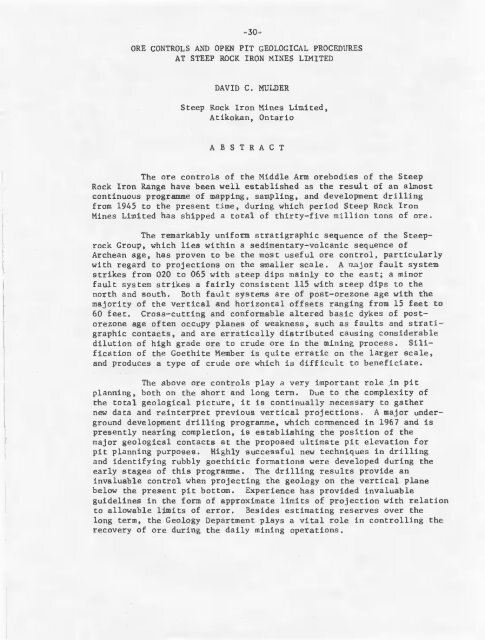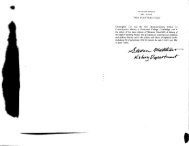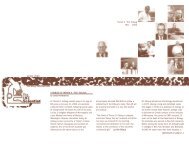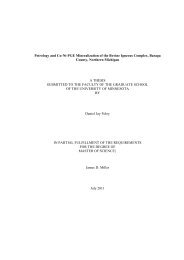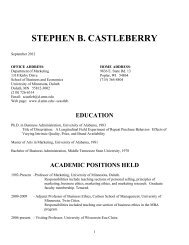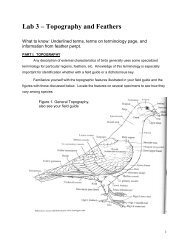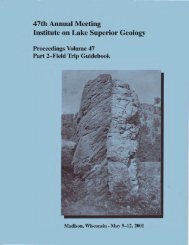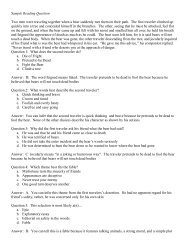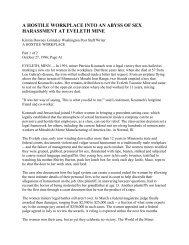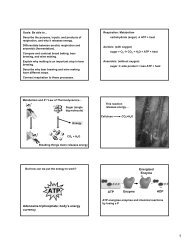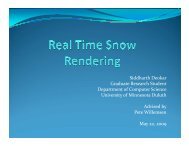Program, Abstracts, and Guidebooks - University of Minnesota Duluth
Program, Abstracts, and Guidebooks - University of Minnesota Duluth
Program, Abstracts, and Guidebooks - University of Minnesota Duluth
Create successful ePaper yourself
Turn your PDF publications into a flip-book with our unique Google optimized e-Paper software.
-30-<br />
ORE CONTROLS AND OPEN PIT GEOLOGICAL PROCEDURES<br />
AT STEEP ROCK IRON MINES LIMITED<br />
DAVID C. MULDER<br />
Steep Rock Iron Mines Limited,<br />
Atikokan, Ontario<br />
ABSTRACT<br />
The ore controls <strong>of</strong> the Middle Arm orebodies <strong>of</strong> the Steep<br />
Rock Iron Range have been well established as the result <strong>of</strong> an almost<br />
continuous programme <strong>of</strong> mapping, sampling, <strong>and</strong> development drilling<br />
from 1945 to the present time, during which period Steep Rock Iron<br />
Mines Limited has shipped a total <strong>of</strong> thirty—five million tons <strong>of</strong> ore.<br />
The remarkably uniform stratigraphic sequence <strong>of</strong> the Steep—<br />
rock Group, which lies within a sedimentary—volcanic sequence <strong>of</strong><br />
Archean age, has proven to be the most useful ore control, particularly<br />
with regard to projections on the smaller scale. A major fault system<br />
strikes from 020 to 065 with steep dips mainly to the east; a minor<br />
fault system strikes a fairly consistent 115 with steep dips to the<br />
north <strong>and</strong> south. Both fault systems are <strong>of</strong> post—orezone age with the<br />
majority <strong>of</strong> the vertical <strong>and</strong> horizontal <strong>of</strong>fsets ranging from 15 feet to<br />
60 feet. Cross—cutting <strong>and</strong> conformable altered basic dykes <strong>of</strong> post—<br />
orezone age <strong>of</strong>ten occupy planes <strong>of</strong> weakness, such as faults <strong>and</strong> strati—<br />
graphic contacts, <strong>and</strong> are erratically distributed causing considerable<br />
dilution <strong>of</strong> high grade ore to crude ore in the mining process. Sill—<br />
fication <strong>of</strong> the Goethite Member is quite erratic on the larger scale,<br />
<strong>and</strong> produces a type <strong>of</strong> crude ore which is difficult to beneficiate.<br />
The above ore controls play a very important role in pit<br />
planning, both on the short <strong>and</strong> long term. Due to the complexity <strong>of</strong><br />
the total geological picture, it is continually necessary to gather<br />
new data <strong>and</strong> reinterpret previous vertical projections. A major underground<br />
development drilling programme, which commenced in 1967 <strong>and</strong> is<br />
presently nearing completion, is establishing the position <strong>of</strong> the<br />
major geological contacts at the proposed ultimate pit elevation for<br />
pit planning purposes. Highly successful new techniques in drilling<br />
<strong>and</strong> identifying rubbly goethitic formations were developed during the<br />
early stages <strong>of</strong> this progranune. The drilling results provide an<br />
invaluable control when projecting the geology on the vertical plane<br />
below the present pit bottom. Experience has provided invaluable<br />
guidelines in the form <strong>of</strong> approximate limits <strong>of</strong> projection with relation<br />
to allowable limits <strong>of</strong> error. Besides estimating reserves over the<br />
long term, the Geology Department plays a vital role in controlling the<br />
recovery <strong>of</strong> ore during the daily mining operations.


